Europe Bio-Medical Waste Management Market Size
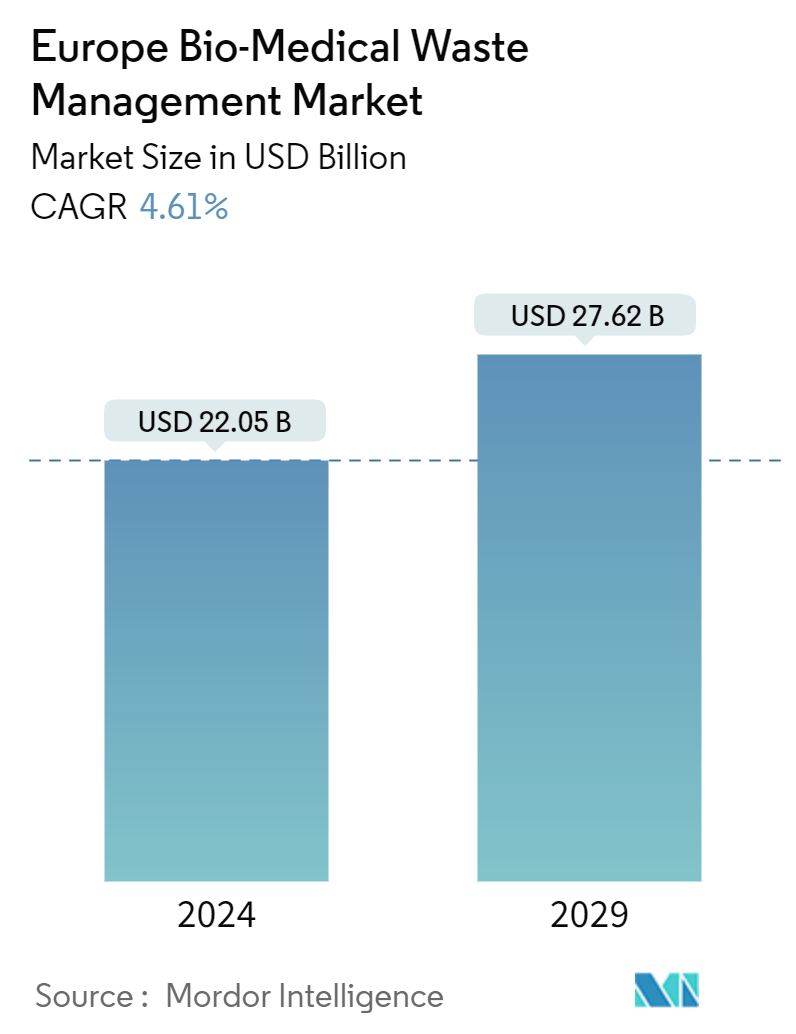
| Study Period | 2020 - 2029 |
| Base Year For Estimation | 2023 |
| Market Size (2024) | USD 22.05 Billion |
| Market Size (2029) | USD 27.62 Billion |
| CAGR (2024 - 2029) | 4.61 % |
| Market Concentration | High |
Major Players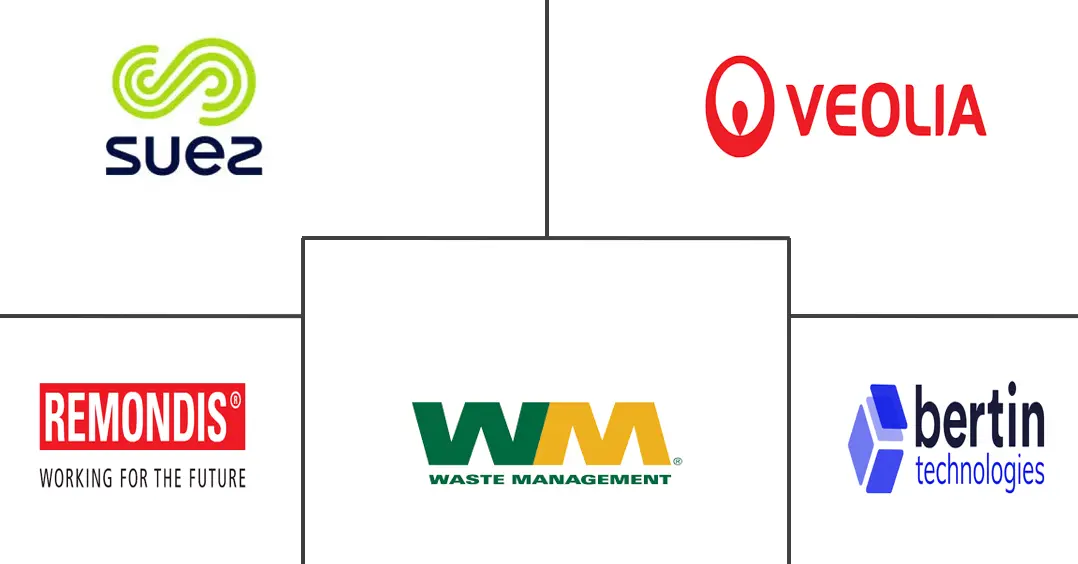
*Disclaimer: Major Players sorted in no particular order |
Europe Bio-Medical Waste Management Market Analysis
The Europe Bio-Medical Waste Management Market size is estimated at USD 22.05 billion in 2024, and is expected to reach USD 27.62 billion by 2029, growing at a CAGR of 4.61% during the forecast period (2024-2029).
The European bio-medical waste management market plays a pivotal role in the waste management industry, spurred by strict regulatory measures, a surge in healthcare activities, and an amplified focus on properly disposing of bio-medical waste.
European hospitals generate around 6 million tons of medical waste yearly, about one-third of which originates in operating rooms. Most of this solid waste is potentially recyclable unless contaminated by bodily fluids. Infectious waste, constituting only 2–3% of hospital waste, is significantly less than the 50–70% found in biohazard waste streams.
Germany's healthcare industry generates a small portion of waste that requires specialized handling. Approximately 5,000 kilograms, or up to 5%, of the country's annual healthcare waste falls under the category of infectious waste. This subset is deemed hazardous due to its infection risk and is thus classified under the Abfallverzeichnisverordnung (AVV), or waste directory regulation.
The production rate of healthcare waste (HCW) varies. It is influenced by waste management practices, the nature of healthcare facilities and their specializations, the availability of reusable equipment, and the daily patient load. Developing nations typically report lower registered HCW production than their developed counterparts. For instance, in Europe, HCW production rates range from 3.5 to 4.4 kg/bed/day, with specific figures like Norway at 3.9 kg/bed/day, Greece varying from 0.3 to 3.6 kg/bed/day, and France at 2.7 to 3.3 kg/bed/day.
Europe's bio-medical waste management market is consistently growing, primarily fueled by the mounting medical waste from expanding healthcare setups, research centers, and diagnostic labs. This growth trend is expected to persist, bolstered by the surging healthcare demands, especially during COVID-19, underscoring the criticality of effective bio-medical waste management.
Regulations from entities like the European Union and national governments underscore the need for proper disposal and treatment of bio-medical waste, emphasizing public health and environmental protection. Technological advancements, including innovations in waste treatment like autoclaving, incineration, and chemical treatments, are boosting the efficiency and safety of bio-medical waste management.
As the number of hospitals, clinics, and research facilities rises, along with the aging demographic, the volume of bio-medical waste also increases. Moreover, a heightened awareness of the risks associated with improper bio-medical waste disposal is spurring the demand for professional waste management services.
While these advanced waste treatment technologies and regulatory compliance are crucial, they come at a significant cost, especially for smaller healthcare entities. Waste management service providers face challenges in navigating the intricate and varied regulations prevalent across European nations.
Europe Bio-Medical Waste Management Market Trends
The Bio-medical Waste Management Market is Set for Significant Growth
The healthcare industry's expansion has significantly boosted medical waste generation, especially in developing nations. With the surge in hospital admissions during the pandemic, the production of bio-medical waste is set to escalate. In a typical developing country, the volume of medical waste generated, averaging 0.5-2.5 kg per bed per day, hinges largely on demographics and healthcare services. As infectious diseases increase, the bio-medical waste management market is primed for substantial growth. Furthermore, the mounting accumulation of microbiological, human anatomical, and animal waste will further expand this market.
In 2004, a WHO policy paper and the Stockholm Convention underscored the risks of incinerating healthcare waste, highlighting heavy metals, acid gases, carbon monoxide, organic compounds, and pathogens. The prevalent methods in developing nations remain small-scale incineration or landfilling. In contrast, many developed countries are phasing out healthcare incinerators favoring dioxin-free technologies. Notably, nations like Ireland, Portugal, and Germany have either shuttered incinerators or placed moratoriums on them, driven by their carbon emission reduction goals and a shift toward waste-to-energy solutions, which, in turn, augments the bio-medical waste management market's potential.
With its rapidly aging population and stringent healthcare waste regulations, Europe presents a favorable landscape for the bio-medical waste management market. Western Europe, for instance, reports bio-medical waste statistics of 3-6 kg per bed, making it a global leader in daily waste generation. Given their robust waste disposal infrastructure and higher waste output, these developed regions are poised to dominate the global bio-medical waste management market.
The bio-medical waste management market is poised for substantial growth, fueled by a surge in medical waste, especially in developing nations. Additionally, stringent regulations and technological innovations in waste management, notably in advanced regions such as Europe, are bolstering the market's prospects.
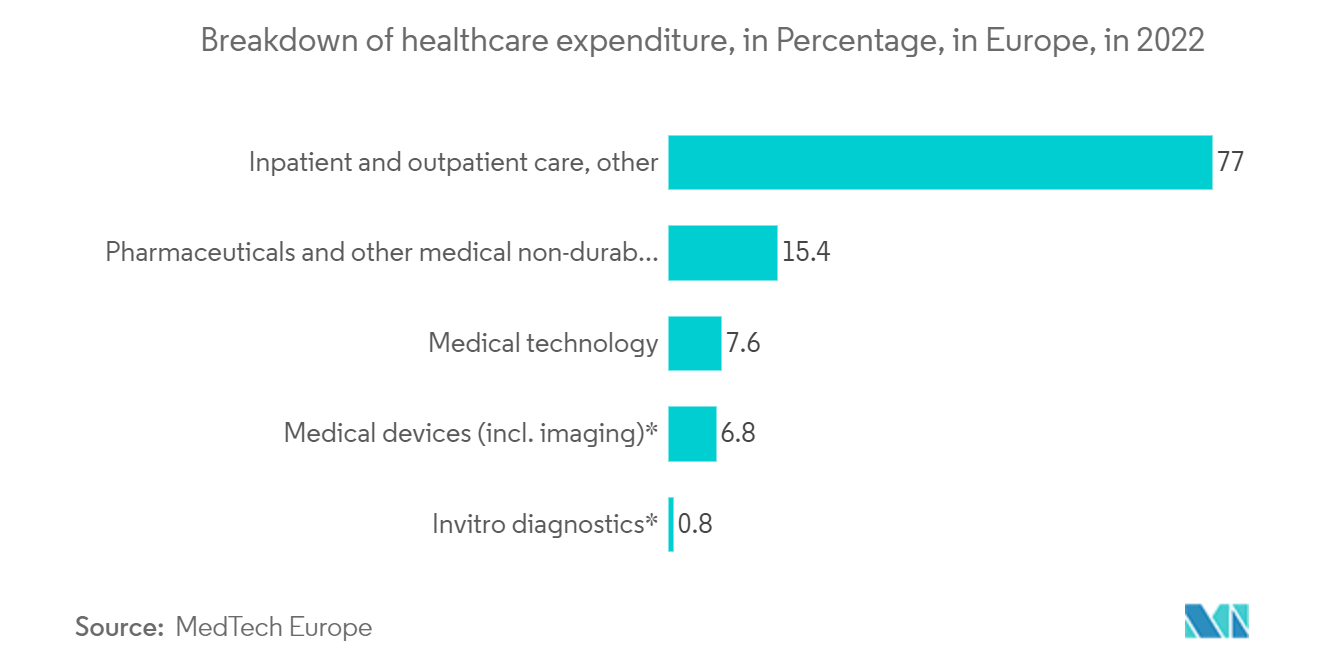
Germany's Highly Regulated System for Handling Bio-medical Waste
Germany boasts a sophisticated and tightly regulated system for managing bio-medical waste. At its core is the Closed Substance Cycle Waste Management Act, which oversees waste prevention, recycling, reuse, and disposal. In addition, healthcare institutions in the country must adhere to infection control and safety mandates.
Hospitals, for instance, appoint a waste disposal overseer responsible for ensuring compliance with safety and legal standards. They also integrate waste disposal into the facility's quality management. Notably, 75-90% of healthcare waste mirrors domestic waste, making it suitable for recycling or incineration via municipal channels.
Facilities handle hazardous items like needles and scalpels in puncture-resistant, leak-proof, and lockable containers. Waste separation begins at the source, with distinct bins and sacs aiding the process. Given its pathogen contamination, specialized companies handle the disposal of this waste.
In Germany, the primary technologies for managing bio-medical waste encompass incineration, chemical disinfection, wet thermal treatment (steam sterilization), microwave irradiation, land disposal, and monetization.
The nation's strategy for bio-medical waste management centers on meticulous segregation, secure handling, and eco-conscious disposal practices. It also underscores recycling and cost-efficiency. This comprehensive system aims to shield healthcare professionals, the public, and the environment from the risks linked to medical waste.
Germany's bio-medical waste management system, supported by stringent regulations and advanced technologies, ensures the secure disposal and recycling of medical waste, with a primary focus on environmental and public safety.
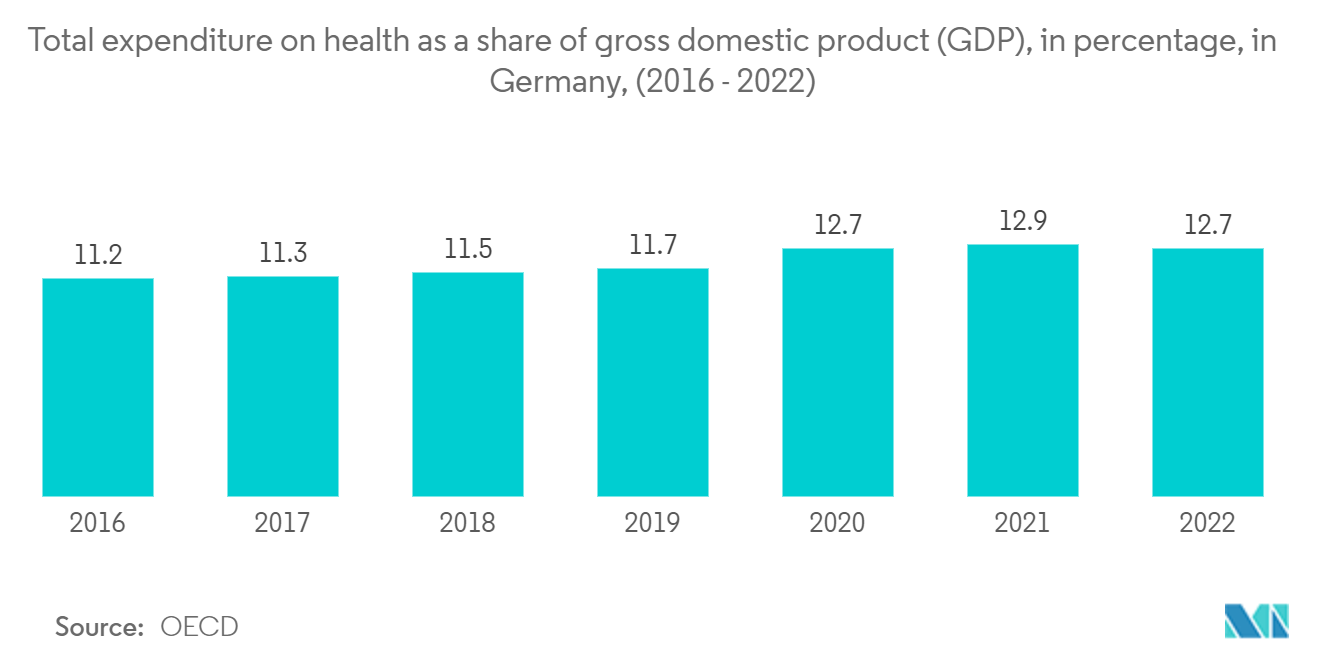
Europe Bio-Medical Waste Management Industry Overview
The European bio-medical waste management market exhibits a moderate to high level of market concentration, with key players wielding dominance. They leverage cutting-edge technologies, adhere to strict regulations, and offer holistic waste management solutions. Some key players are SUEZ Group, Veolia Environmental Services, Remondis Medison, WM Intellectual Property Holdings LLC, and Bertin Technologies.
Europe Bio-Medical Waste Management Market Leaders
-
SUEZ Group
-
Veolia Environmental Services
-
Remondis Medison
-
WM Intellectual Property Holdings, L.L.C
-
Bertin Technologies
*Disclaimer: Major Players sorted in no particular order
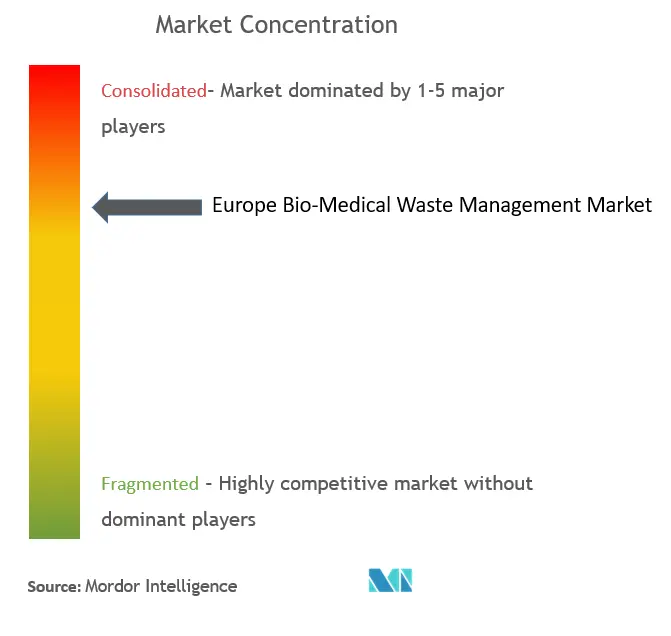
Europe Bio-Medical Waste Management Market News
- June 2024: Waste Management Inc. and Stericycle confirmed a definitive agreement, with Waste Management acquiring all outstanding shares of Stericycle at USD 62.00 per share in cash. This deal, totaling approximately USD 7.2 billion, accounts for Stericycle's net debt of around USD 1.4 billion. With this acquisition, Waste Management is expected to broaden its environmental solutions portfolio by incorporating Stericycle's prominent assets in the lucrative medical waste and secure information destruction industries.
- September 2023: LabCycle, a company co-founded by a University of Bath graduate, unveiled its pilot plant capable of recycling up to 60% of plastic lab waste. With ambitions to expand, the company targets recycling waste from labs, healthcare, research, and commercial sectors.
- January 2023: Bertin Medical Waste's Sterilwave solution earned accolades from the United Nations Industrial Development Organization (UNIDO) in 2022. This recognition came during the UNIDO Global Call, specifically in the Medical & Health category. UNIDO lauded Sterilwave for its innovative and responsible approach to medical waste treatment.
Europe Bio-Medical Waste Management Market Report - Table of Contents
1. INTRODUCTION
- 1.1 Study Deliverables
- 1.2 Study Assumptions
- 1.3 Scope of the Study
2. RESEARCH METHODOLOGY
3. EXECUTIVE SUMMARY
4. MARKET DYNAMICS
- 4.1 Market Overview
-
4.2 Market Drivers
- 4.2.1 Surging Demand for Healthcare Services
- 4.2.2 Rise in Surgical Procedures
-
4.3 Market Restraints
- 4.3.1 High Operational Costs
-
4.4 Market Opportunities
- 4.4.1 The Government is Allocating Significant Funds to Bolster Healthcare Infrastructure and Enhance Waste Management Programs
- 4.5 Value Chain / Supply Chain Analysis
-
4.6 Porter's Five Force Analysis
- 4.6.1 Threat of New Entrants
- 4.6.2 Bargaining Power of Buyers/Consumers
- 4.6.3 Bargaining Power of Suppliers
- 4.6.4 Threat of Substitute Products
- 4.6.5 Intensity of Competitive Rivalry
- 4.7 Insights on Technology Innovation in the Market.
- 4.8 Impact of Geopolitics and Pandemics on the Market
5. MARKET SEGMENTATION
-
5.1 By Waste Type
- 5.1.1 Hazardous
- 5.1.2 Non-hazardous
-
5.2 By Service Type
- 5.2.1 Collection
- 5.2.2 Transportation and Storage
- 5.2.3 Treatment and Disposal
- 5.2.4 Other Service Types
-
5.3 By Country
- 5.3.1 Germany
- 5.3.2 United Kingdom
- 5.3.3 France
- 5.3.4 Russia
- 5.3.5 Spain
- 5.3.6 Rest of Europe
6. COMPETITIVE LANDSCAPE
- 6.1 Market Concentration Overview
-
6.2 Company Profiles
- 6.2.1 SUEZ Group
- 6.2.2 Veolia Environmental Services
- 6.2.3 Remondis Medison
- 6.2.4 WM Intellectual Property Holdings LLC
- 6.2.5 Bertin Technologies
- 6.2.6 Cleansing Service Group (CSG)
- 6.2.7 Rhenus Group
- 6.2.8 Initial Medical Services
- 6.2.9 Biffa
- 6.2.10 Cannon Hygiene
- 6.2.11 Cleanaway
- 6.2.12 Grundon Waste Management
- 6.2.13 Viridor
- *List Not Exhaustive
7. FUTURE TRENDS
** Subject To AvailablityEurope Bio-Medical Waste Management Industry Segmentation
Bio-medical waste (BMW) is generated during human or animal diagnosis, treatment, immunization, or related research activities. This waste also includes byproducts from the production or testing of biological materials and waste from health camps.
The European bio-medical waste management market is segmented by type of waste (hazardous and non-hazardous waste), service type (collection, transportation and storage, treatment and disposal, and other service types), and country (Germany, United Kingdom, France, Russia, Spain, and Rest of Europe). The report offers market sizes and forecasts in terms of value (USD) for all the above segments.
Europe Bio-Medical Waste Management Market Research FAQs
How big is the Europe Bio-Medical Waste Management Market?
The Europe Bio-Medical Waste Management Market size is expected to reach USD 22.05 billion in 2024 and grow at a CAGR of 4.61% to reach USD 27.62 billion by 2029.
What is the current Europe Bio-Medical Waste Management Market size?
In 2024, the Europe Bio-Medical Waste Management Market size is expected to reach USD 22.05 billion.
Who are the key players in Europe Bio-Medical Waste Management Market?
SUEZ Group, Veolia Environmental Services, Remondis Medison, WM Intellectual Property Holdings, L.L.C and Bertin Technologies are the major companies operating in the Europe Bio-Medical Waste Management Market.
What years does this Europe Bio-Medical Waste Management Market cover, and what was the market size in 2023?
In 2023, the Europe Bio-Medical Waste Management Market size was estimated at USD 21.03 billion. The report covers the Europe Bio-Medical Waste Management Market historical market size for years: 2020, 2021, 2022 and 2023. The report also forecasts the Europe Bio-Medical Waste Management Market size for years: 2024, 2025, 2026, 2027, 2028 and 2029.
Europe Bio-Medical Waste Management Industry Report
Statistics for the 2024 Europe Bio-Medical Waste Management market share, size and revenue growth rate, created by Mordor Intelligence™ Industry Reports. Europe Bio-Medical Waste Management analysis includes a market forecast outlook for 2024 to 2029) and historical overview. Get a sample of this industry analysis as a free report PDF download.



